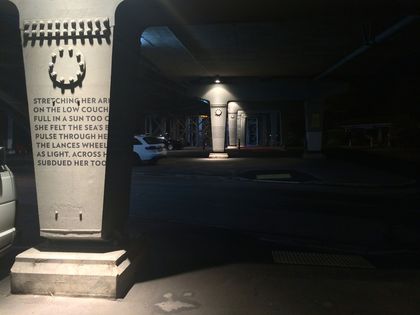Skypath – the cycle & pedestrian path on the Auckland bridge – is a good thing. I’m looking forward to using it. But some of those celebrating its recently-granted resource consent could show more sympathy to the people of Northcote point, some of whom were inclined to oppose it.
I like Northcote point. I like the cinema, the restaurants, the ferries, and one of Auckland’s best (and few remaining) pubs. But the best bit is right at the end. You can’t really see it on the Internet (although it’s poetic that the Auckland Council consent documents have a couple of blurry shots). Google’s street view won’t take you there, even though there’s a road with houses on it. There are no photographs posted there, either on Google or Flickr No, you have to go there.
The road narrows and then suddenly slips under the bridge, like a secret doorway into a private world. Wide swathes of red paint extend the tarmac in a way that says “caution”. Poetry adorns the pillars of the bridge. The road weaves through the infrastructure, connecting hunkered-down houses, which are partly obscured by the steel and concrete (the same houses occupy the peripheral vision of motorists flying north and south). It feels vaguely military and strangely dignified, almost as if part of the Auckland Museum broke off and moved in, along with the other residents.
You sort of wonder if somebody in council thought to themselves, hey, these guys have to live under a bridge; least we can do is make it interesting.
But before long you start to feel like an intruder. People who live under bridges have usually made a bold decision. It’s as if these people have found some kind of a loophole in Auckland’s property market. A place where they can have whatever they want, as long as they don’t mind Auckland flying past at motorway speed just metres overhead.
None of which lessens the importance of Skypath (despite its Hollywood-sounding name). But when Auckland Council says in a press release that the opponents’ needs can be addressed, it would be helpful if someone could explain how, exactly. The concerns, of course, are that Skypath – if done badly – will rip through this preserved little sub-commun`ity like a truck through a playground. The Northcote Residents’ Association submitted a hundred page opposition, centred mainly on two questions, which are “Where is the parking?” and “How will Skypath’s traffic and huge crowds be managed?”
They seem like good questions. While marauding hordes of misanthropic pedestrians and cyclists is probably unlikely, that’s not really a design solution, or the point, is it? The Northcote people’s concerns are about worst case scenarios, which are best case scenarios for Skypath’s supporters.
And the parking concerns seem at least partly justified. Perhaps it’s a function of urban sprawl that people – everywhere – who live in once-quiet, once-remote suburbs might wake up one day to find a resident’s-only street-parking sticker in the mail.
It’s not fair to write this off to a NIMBY attitude. Nobody wants to live inside lousy design. The report’s author takes care to point out that Skypath is a good idea, but that if its execution is flawed, it becomes a problem. Then again, who knows? Maybe they’re just hooking in for all the compo they can.
Well, if it turns out that the project makes the place uninhabitable from their point of view, then good luck to them. They wouldn’t be the first to be displaced by transport infrastructure.
I have other concerns about Auckland’s thankfully-ever-growing cycle network. Mainly, I’m worried about the shared access between pedestrians and cyclists. As a regular user of the north-west shared cycle way, keeping an eye out for unlit pedestrians is a major concern. As cycle traffic grows, it looks very likely somebody’s going to get knocked off their feet.
Skypath is reportedly to be 4m wide. According to Auckland Transport’s cycling manager Kathryn King, a cyclist needs 1m around them. If a cyclist overtakes another cyclist, and there’s cyclists heading in both directions, and there’s pedestrians around, and kids … dogs … it’s not hard to foresee accident potential. And don’t presume every cyclist will be lolling along on a retro frame with a poodle in a basket. It is, after all, a major transport thoroughfare, and has potential to get busy. I’d have thought a central lane divider would be a minimum, as it is for the cars and trucks.
The simplest solution would be to disallow pedestrians. But that’s not very friendly, is it? And it probably alienates the project from vast tracts of tourism potential, which is always politically popular. So a separated footpath would also be a good idea.
It would cost more. But I think too many cycleways are designed as shared spaces without consideration of the risks, or future capacity. It’s one thing to have an urban shared space of cobblestones and cafes like Forte St. But a narrow corridor with chunks of carbon fibre travelling at over 30km is a different thing altogether. That’s a wider problem that I think Auckland is going to have to address very soon.
I’d understand if the cycle lobbyists regarded shared space as a sort of funding concession. But it looks like a false economy to me.
Meanwhile, bring on Skypath, and the $111m cycle-way budget, which apparently translates to about 52 km. But please, cycle advocates, don’t get caught up in the same self-justifying, self-righteous rhetoric that made the roading industry what it is today. It needs a user-centred design philosophy, that includes local residents among the key stakeholders.
Republished from James Littlewood's personal blog, Pitchbender.
